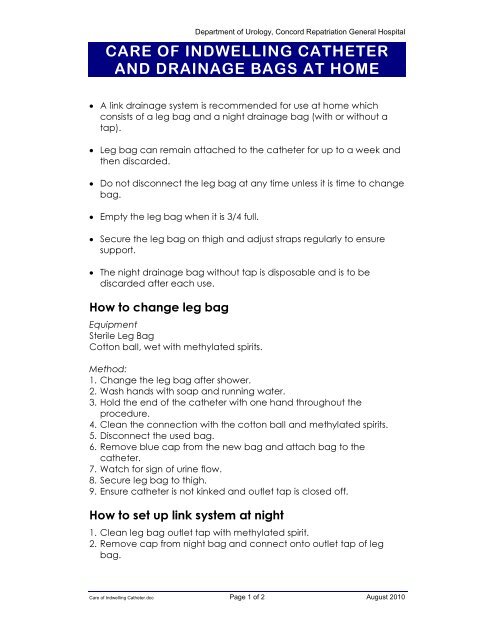Care of Indwelling Catheter
Care of Indwelling Catheter
Care of Indwelling Catheter
You also want an ePaper? Increase the reach of your titles
YUMPU automatically turns print PDFs into web optimized ePapers that Google loves.
Department <strong>of</strong> Urology, Concord Repatriation General Hospital<br />
CARE OF INDWELLING CATHETER<br />
AND DRAINAGE BAGS AT HOME<br />
• A link drainage system is recommended for use at home which<br />
consists <strong>of</strong> a leg bag and a night drainage bag (with or without a<br />
tap).<br />
• Leg bag can remain attached to the catheter for up to a week and<br />
then discarded.<br />
• Do not disconnect the leg bag at any time unless it is time to change<br />
bag.<br />
• Empty the leg bag when it is 3/4 full.<br />
• Secure the leg bag on thigh and adjust straps regularly to ensure<br />
support.<br />
• The night drainage bag without tap is disposable and is to be<br />
discarded after each use.<br />
How to change leg bag<br />
Equipment<br />
Sterile Leg Bag<br />
Cotton ball, wet with methylated spirits.<br />
Method:<br />
1. Change the leg bag after shower.<br />
2. Wash hands with soap and running water.<br />
3. Hold the end <strong>of</strong> the catheter with one hand throughout the<br />
procedure.<br />
4. Clean the connection with the cotton ball and methylated spirits.<br />
5. Disconnect the used bag.<br />
6. Remove blue cap from the new bag and attach bag to the<br />
catheter.<br />
7. Watch for sign <strong>of</strong> urine flow.<br />
8. Secure leg bag to thigh.<br />
9. Ensure catheter is not kinked and outlet tap is closed <strong>of</strong>f.<br />
How to set up link system at night<br />
1. Clean leg bag outlet tap with methylated spirit.<br />
2. Remove cap from night bag and connect onto outlet tap <strong>of</strong> leg<br />
bag.<br />
<strong>Care</strong> <strong>of</strong> <strong>Indwelling</strong> <strong>Catheter</strong>.doc Page 1 <strong>of</strong> 2 August 2010
Department <strong>of</strong> Urology, Concord Repatriation General Hospital<br />
3. Open outlet tap for free drainage and adjust straps for comfort and<br />
alignment.<br />
4. Support night bag on wire hanger by the bed in a downhill direction.<br />
5. Each morning disconnect the night bag and ensure leg bag outlet<br />
tap is closed.<br />
6. If the night bag is disposable cut the bag and empty urine into toilet,<br />
then dispose <strong>of</strong> the bag. If the night bag is reusable empty all the<br />
urine into the toilet and clean the bag so it can be used again. (See<br />
cleaning drainage bags for how to clean reusable bags).<br />
POSSIBLE PROBLEMS AND WHAT TO DO<br />
• <strong>Catheter</strong> leakage<br />
• (by passing)<br />
• Bladder spasm<br />
• (cramps)<br />
• No Urine Draining<br />
• Urinary Tract Infection<br />
• Cloudy smelling urine<br />
• Pain and soreness<br />
• Discharge<br />
• Bleeding<br />
• <strong>Catheter</strong> falls out<br />
• Ensure there are no kinks<br />
• Ensure you eat high fibre diet to<br />
avoid constipation<br />
• Ensure you drink more than 2<br />
litre <strong>of</strong> fluid each day.<br />
• Ensure catheter and bag are<br />
secured to reduce irritation to<br />
your bladder or urethra.<br />
• Check for kinks.<br />
• Ensure bag is below bladder<br />
level.<br />
• Milk the catheter.<br />
• Drink more fluids if needed.<br />
• Drink plenty <strong>of</strong> fluid, at least 2<br />
litres/day<br />
• Contact your nurse or doctor<br />
• Contact your nurse or doctor<br />
<strong>Care</strong> <strong>of</strong> <strong>Indwelling</strong> <strong>Catheter</strong>.doc Page 2 <strong>of</strong> 2 August 2010

















